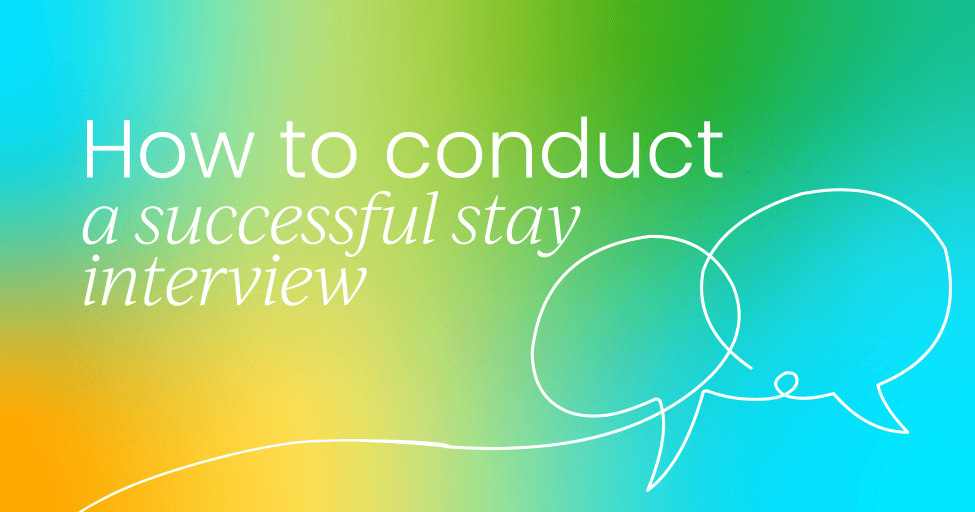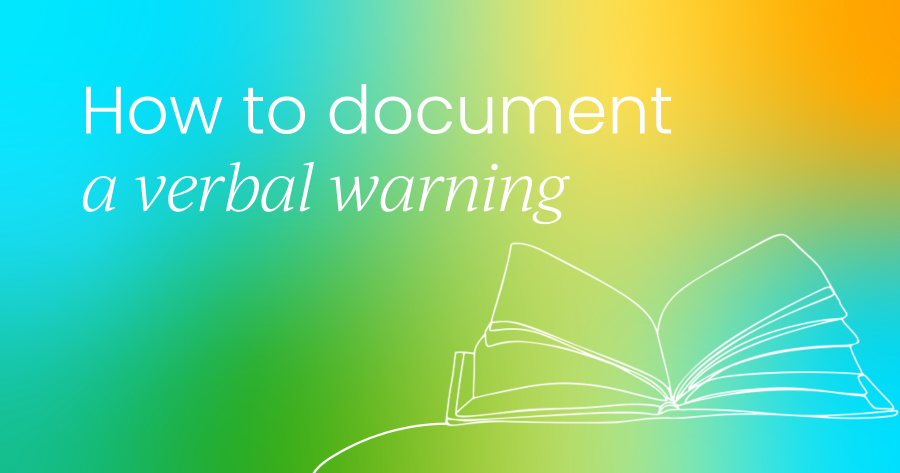Verbal warnings at work are often the first step in a progressive disciplinary process, offering an opportunity to course-correct minor issues before they escalate. However, the very "verbal" nature of these warnings can lead to miscommunication, inconsistency, and a lack of proper documentation, which can potentially expose your company to unnecessary risk.
That's why we've created this verbal warning template and handy guide to help you out. We'll walk you through how to approach these delicate conversations with confidence and ensure you're acting compliantly every step of the way.
By the time you finish reading this guide, you’ll have everything you need to transform potentially uncomfortable disciplinary discussions into clear, constructive interactions that benefit everyone involved.
Table of contents
- What a verbal warning is
- Verbal vs written: Knowing the difference
- Why it's so important
- Common reasons for verbal warnings
- Tips for an effective discussion
- Documenting verbal warnings
What is a verbal warning?
A verbal warning is the important first chat you have with an employee when something's just a little bit off. It's not a shouting match, nor is it meant to be a formal telling-off that leaves someone feeling terrible. It’s essentially an initial, informal conversation where you address a minor issue concerning an employee's conduct or performance.
The key here is "initial" and "informal," but don't let "informal" fool you!
While it's a conversation, it's still a significant step. Its main purpose is to catch small problems early. Delivering a verbal warning at work gives the employee a heads-up, a clear understanding of what's gone wrong, and a chance to course-correct.
Verbal vs written: Knowing the difference
A verbal warning is usually the very first rung on the disciplinary ladder. It's less formal than a written warning, but it should always be documented, nonetheless (grab your verbal warning template to help with this). Your main goal with a verbal warning is opening a dialogue, setting clear expectations for improvement, and offering support.
On the other hand, a written warning is a more serious step. It typically follows a verbal warning if the issue hasn't improved, or if the initial misconduct is more severe from the outset (though not so severe as to warrant immediate dismissal).
Written warnings are formal documents placed in an employee's personnel file and usually have a set timeframe for review and potential escalation if the behaviour or performance doesn't change. Think of it as moving from a quiet word of caution to a more formal warning.

3 reasons why verbal warnings are so important
We’ve defined what a verbal warning is, but why bother with this “informal” step at all? It might seem minor, but it’s actually a very important part of effective management. Here’s three reasons why:
1. It’s your early warning system
A verbal warning lets you step in while the issue is still small and (hopefully) before it turns into a full-blown HR emergency. It’s your chance to course-correct before things get messy (and expensive).
2. It clears up confusion
Have you ever assumed someone must know they’re doing something wrong... but it turns out they had no idea? It happens all the time.
A verbal warning is your moment to hit pause and say, “Hey, here’s what’s not working, and here’s what needs to change.” It’s short, clear, and gets everyone on the same page.
3. It keeps things fair
People notice when some teammates get called out and others don’t. That’s how trust issues start forming within a company.
Giving verbal warnings consistently helps you treat everyone fairly. It shows there’s a process, not just gut decisions or favoritism.
Common reasons for verbal warnings
Nobody wants to give a verbal warning, and no one ever wants to get one. But they do happen and honestly, it’s not always a bad thing. Verbal warnings aren’t about punishment, they’re about growth, clarity, and getting back on track.
But what are some common reasons for one? A few include:
- Showing up late (frequently): Chronic lateness is one of the most common reasons managers step in with a quick verbal reminder.
- Missing deadlines or dropping the ball: If someone keeps missing deadlines, forgetting tasks, or delivering half-finished work, it’s time for a reset.
- Poor communication: Communication issues are subtle but damaging.
- Attitude check: We’ve all worked with someone who sighs dramatically during meetings or shoots passive-aggressive emails. It brings the whole team down and if it’s an ongoing issue, it might be worth having a chat.
- Not following basic policies: Things like skipping safety steps, ignoring dress codes, or taking a few too many “extra” breaks can lead to a verbal warning.

Tips for an effective discussion

Getting this right can turn a potentially awkward chat into a truly productive one. Let's break it down into what you should do and what you should definitely avoid.
Part 1: Before the conversation
Preparation is key, so don’t skip it!
1. Gather the facts
Make sure you have your ducks in a row before setting up a meeting. You need to know exactly what happened, when, who was involved, and have evidence on-hand (such as emails, witness accounts, etc.).
The last thing you want to do is show up without clear examples or knowledge of company policies. Doing so can make you look unprofessional and weaken your message.
2. Check your policies
Always double-check your company's specific policies on the issue at hand and your progressive discipline process. Are you following the right steps? This keeps you consistent and compliant.
3. Choose an appropriate setting
Find a private office or meeting room where you won't be interrupted, and the employee feels comfortable speaking freely. Never have this conversation in an open-plan office, break room, or anywhere else where others can overhear.
Part 2: During the discussion
This is where your direct communication skills come into play.
4. State the purpose clearly & directly
Start by telling them exactly why you're meeting and don’t beat around the bush. Try to avoid being vague or using generic language, neither of which will help the employee fully understand the situation. Instead, use concrete examples and provide, dates, times, and specific actions.
5. Explain the impact
Help them understand why it matters. "Being late impacts team productivity as others have to cover your duties during that time," or "Missing that detail on the report caused a delay in client communication."
6. Listen to the employee's perspective
Give them space to explain, ask questions, or offer context. "Do you have any thoughts on why this has been happening?" or "Is there anything preventing you from meeting this expectation?" Listen actively, without interrupting. You can correct factual inaccuracies calmly later, but let them feel heard.
7. Clearly state expectations for improvement
What exactly do you need them to do differently? Make sure to articulate expectations clearly and emphasize what "improved" looks like. It’s also important to set a realistic timeline for improvement.
8. Outline consequences
Clearly state what happens if the issue isn't resolved such as:
"If this issue with punctuality continues, the next step in our progressive discipline process would be a formal written warning."
This will help to set clear boundaries.
Remember to maintain a professional, constructive tone and keep emotions out of it. The goal is to correct, not to shame.

Part 3: The follow-through
The conversation doesn't end when the employee leaves the room.
9. Document the conversation immediately
This is critical. Even though it's a "verbal" warning, the documentation of that conversation is what protects you and ensures consistency. Note down the date, time, attendees, the specific issue discussed, expectations set, resources offered, and consequences outlined. Our verbal warning template will make this documentation process a lot easier for you.
10. Schedule follow-up meetings (if appropriate)
If you set a timeline for improvement, schedule a follow-up to check in on their progress. This reinforces accountability and shows you're serious about supporting them.
Documenting verbal warnings
Just because it’s verbal doesn’t mean it should vanish into thin air.
Have you ever had a situation where you swear you talked to someone about an issue... but a few weeks later, they act like it never happened? Yeah. That’s exactly why documentation matters, even for a casual chat.
You should always document a verbal warning because you’ll need it to provide:
Legal protection
Let’s say things escalate later. You want to be able to show that you followed a fair, reasonable process. Having that quick note in the file proves you gave the employee a chance to improve before taking bigger steps.
Consistency
Ever been accused of favoritism or being “too hard” on one person but not another? Documentation helps you stay consistent across the board. It shows that every employee gets the same chance and the same process.
Tracking progress
Maybe the employee gets back on track (awesome). Maybe they don’t (less awesome). Either way, your notes give you a way to look back and see if things are improving, or if it’s time for next steps.
Future reference
Let’s fast forward a few months. There’s a repeat issue. Guess what’ll come in handy? That documented chat from earlier. It gives context, reinforces expectations, and helps justify further action (if needed).
What should you document?
You simply need to capture the essentials of the conversation, such as the:
- Date of the discussion
- The employee’s name and role
- A short summary of the issue discussed
- The expectation moving forward
- Any next steps (including timelines or check-ins)
- Your name and who else (if anyone) was present
It doesn’t need to be fancy, just clear and specific. A simple verbal warning template can make this super easy. Fill it out right after the chat while it’s still fresh, and you’re covered.
Download your free Verbal Warning email template
We've created a practical and easy-to-use verbal warning email template specifically designed for HR and People leaders like you.
This verbal warning template isn't just a blank form; it's a guide to ensure you capture all the essential details, maintain consistency, and protect your organization.



 Follow us on LinkedIn
Follow us on LinkedIn



